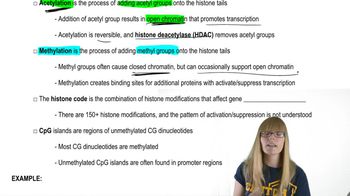Table of contents
- 1. Introduction to Genetics51m
- 2. Mendel's Laws of Inheritance3h 37m
- 3. Extensions to Mendelian Inheritance2h 41m
- 4. Genetic Mapping and Linkage2h 28m
- 5. Genetics of Bacteria and Viruses1h 21m
- 6. Chromosomal Variation1h 48m
- 7. DNA and Chromosome Structure56m
- 8. DNA Replication1h 10m
- 9. Mitosis and Meiosis1h 34m
- 10. Transcription1h 0m
- 11. Translation58m
- 12. Gene Regulation in Prokaryotes1h 19m
- 13. Gene Regulation in Eukaryotes44m
- 14. Genetic Control of Development44m
- 15. Genomes and Genomics1h 50m
- 16. Transposable Elements47m
- 17. Mutation, Repair, and Recombination1h 6m
- 18. Molecular Genetic Tools19m
- 19. Cancer Genetics29m
- 20. Quantitative Genetics1h 26m
- 21. Population Genetics50m
- 22. Evolutionary Genetics29m
13. Gene Regulation in Eukaryotes
Epigenetics, Chromatin Modifications, and Regulation
Problem 15
Textbook Question
Imprinting disorders do not involve changes in DNA sequence, but only the methylated state of the DNA. Does it seem likely that imprinting disorders could be treated by controlling the maternal environment in some way, perhaps by dietary changes?
 Verified step by step guidance
Verified step by step guidance1
Understand that imprinting disorders are caused by epigenetic changes, specifically the methylation patterns on DNA, rather than changes in the DNA sequence itself.
Recognize that the methylation state of DNA can be influenced by environmental factors, including diet, which can affect the availability of methyl groups necessary for DNA methylation.
Consider how maternal diet could potentially influence the methylation patterns during critical periods of development, such as during pregnancy, when epigenetic marks are established.
Explore existing research or case studies where dietary interventions have been used to modify epigenetic marks, particularly in the context of imprinting disorders.
Evaluate the feasibility and ethical considerations of using dietary changes as a treatment strategy for imprinting disorders, taking into account the complexity of epigenetic regulation and individual variability.
Recommended similar problem, with video answer:
 Verified Solution
Verified SolutionThis video solution was recommended by our tutors as helpful for the problem above
Video duration:
37sPlay a video:
Was this helpful?
Key Concepts
Here are the essential concepts you must grasp in order to answer the question correctly.
Genomic Imprinting
Genomic imprinting is an epigenetic phenomenon where certain genes are expressed in a parent-of-origin-specific manner. This means that for some genes, only the allele inherited from one parent is active, while the other is silenced. Imprinting is regulated by DNA methylation and histone modifications, which do not change the DNA sequence but affect gene expression.
Recommended video:
Guided course

Genomics Overview
Epigenetics
Epigenetics refers to the study of heritable changes in gene expression that do not involve alterations to the underlying DNA sequence. These changes can be influenced by various factors, including environmental conditions, lifestyle, and diet. Understanding epigenetics is crucial for exploring how external factors might impact imprinting disorders and their potential treatments.
Recommended video:
Guided course

Chromatin
Maternal Environment and Nutrition
The maternal environment, including nutrition, can significantly influence fetal development and gene expression through epigenetic mechanisms. Dietary components can affect the methylation patterns of genes, potentially altering the risk of imprinting disorders. Research suggests that optimizing maternal nutrition may help mitigate some effects of these disorders, highlighting the importance of maternal health during pregnancy.
Recommended video:
Guided course

Maternal Effect





